Effective Tree Stump Removal: Techniques & Tips
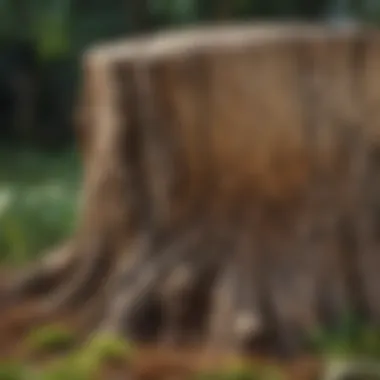
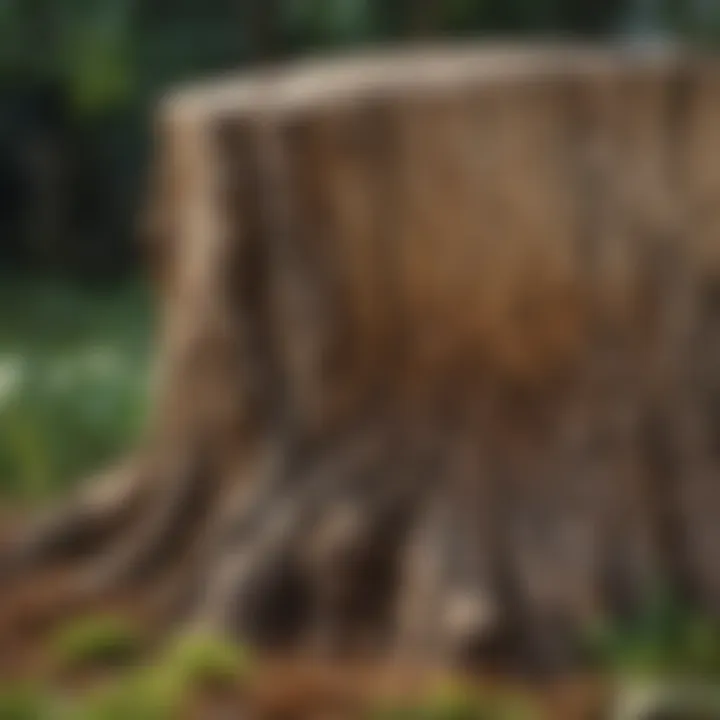
Intro
Removing a tree stump can seem like a daunting task, yet it is essential for restoring the beauty of your outdoor space. Whether you want to plant new trees, create a garden, or simply eliminate an eyesore, understanding the various methods available for stump removal can make the process less overwhelming. This guide provides an in-depth analysis of mechanical and chemical techniques for stump removal, as well as safety considerations and post-removal care, aimed at homeowners and gardening enthusiasts.
Stumps can remain after tree removal for several reasons. Sometimes they provide a safety hazard, while in other cases, they hinder landscaping efforts. Regardless of your motivation, tackling stump removal effectively is key to rejuvenating your outdoor environment. In this article, you'll find a detailed discussion on not only how to remove stumps but also how to ensure the area remains healthy after their removal. The insights shared here cater to a range of needs, making the task more manageable for everyone.
Design Inspiration
When envisioning your outdoor space, consider how removing a tree stump can transform the area. A clear yard can enhance garden layouts and improve the overall aesthetic. Imagine a vibrant flower bed where a stump used to stand. While tree stumps can break the flow of the landscape, their removal opens pathways for new design ideas.
Trending Styles
Many homeowners are leaning towards minimalist landscapes and native plant gardens. These styles promote sustainability and ease of maintenance, and they can thrive in areas previously occupied by tree stumps. Consider incorporating features like:
- Rock gardens that require minimal upkeep.
- Flowing pathways that guide visitors through the space.
- Native plants that adapt well to the local climate, helping reduce water usage.
Color Palettes
Selecting a cohesive color palette is crucial for outdoor design. Before removing the stump, think about colors you want to feature in your garden. Earthy tones, such as greens and browns, usually work well, but you may also explore vibrant floral colors. The removal of the stump can create a clean slate, making it easier to visualize and implement your desired color scheme.
Practical Tips
Executing the removal of a tree stump comes with its challenges. Here are some practical tips to consider for a smooth and effective process.
Maintenance & Care
After removing a stump, regular maintenance will help improve soil health and prepare it for new growth. Some steps include:
- Inspecting the area for any remnants of the stump, as these can hinder future planting.
- Filling the hole with nutrient-rich soil to promote healthy planting conditions.
- Watering the area regularly to keep the soil moist during the transition.
Budgeting & Planning
Budgeting is crucial when planning stump removal. Mechanical methods like stump grinders can be more expensive but may offer quicker results. On the other hand, chemical methods can be cheaper but may take longer to see effective results. To better prepare:
- Assess your budget and choose between mechanical or chemical options.
- Gather necessary tools or hire professionals based on your chosen method.
- Schedule the removal based on your seasonal planting plans.
Proper planning prevents hasty decisions that can lead to overspending or ineffective removal efforts.
By methodically approaching the stump removal process, you will achieve your desired outdoor transformation efficiently and effectively.
Understanding Tree Stumps
Understanding tree stumps is fundamental in the process of removal. Knowing the characteristics of a tree stump guides the homeowner in selecting the appropriate method for removal. Each stump can vary significantly in size, species, and root structure. Different woods can decompose at different rates, affecting how quickly the stump can be removed or what method may be most effective. Stumps left unaddressed can lead to aesthetic issues, pest infestations, and can even hinder future landscaping plans.
What is a Tree Stump?
A tree stump is the remains of a tree after it has been cut down. This is often all that is left above ground when a tree is felled. The stump includes the tree’s trunk and a portion of the root system, which may still be alive. It is essential to understand that the stump can continue to grow new shoots and foliage from the remaining root system. Depending on the species of the tree, the stump can become a breeding ground for pests, making it crucial to address it as soon as possible.
Causes for Stump Removal
There are several reasons why a homeowner may decide to remove a tree stump:
- Aesthetic Appeal: Stumps can disrupt the visual harmony of the landscape. They can detract from the natural beauty of the yard, making it look unkempt.
- Safety Hazards: A stump can create tripping hazards, especially in yards where children play or if the area is used for entertaining guests.
- Pest Control: Tree stumps can attract insects such as termites, ants, and beetles, which can lead to infestations in other wooden structures nearby.
- Landscaping Needs: If a homeowner plans to replant or redesign the landscape, removing the stump makes the process smoother and allows for new growth.
The Impact of Tree Stumps on Landscaping
Tree stumps present several challenges to effective landscaping. They consume space, which can limit design options. Stumps can hinder the growth of new plants by competing for resources. Roots from the stump can spread underground, obstructing the planting of new vegetation or installation of hardscape features.
The presence of tree stumps affects not only the appearance but also the health of the entire landscape.
Additionally, stumps can alter the soil conditions by affecting drainage and aeration. As such, managing tree stumps is critical for maintaining a healthy, beautiful yard that aligns with homeowner aspirations for their outdoor spaces.
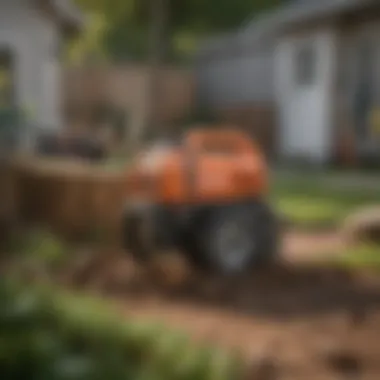
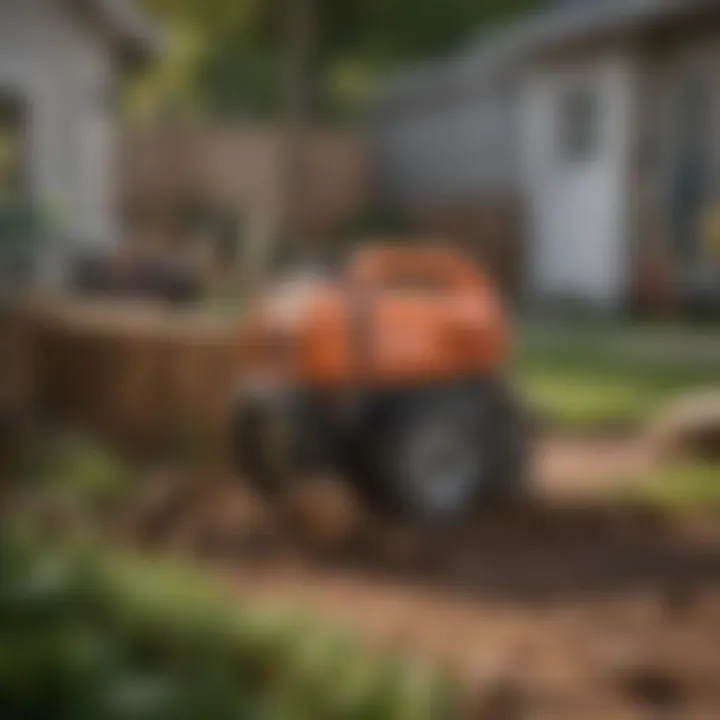
Preparation for Stump Removal
Preparing for stump removal is a crucial stage that cannot be overlooked. This part of the process sets the foundation for an effective and efficient removal. Having a clear strategy in place ensures not only safety but also a higher chance of success. Proper preparation minimizes disruptions and addresses potential challenges early. When a homeowner decides to remove a tree stump, taking the time to prepare can save both time and resources in the long run.
Assessing the Stump
Before proceeding with any removal methods, it is essential to assess the stump carefully. Begin by measuring its height and diameter. A larger stump might require more extensive equipment or different techniques when compared to a smaller one. Additionally, evaluate the condition of the stump. If it is rotting or has been invaded by pests, this may indicate the need for different tools or methods. Furthermore, consider its location. Is it near power lines, roots of other trees, or structures? These factors influence how you approach the stump removal. Take comprehensive notes during this assessment, as it could help in selecting the right method later.
Gathering Necessary Tools
Once you have assessed the stump thoroughly, the next step is to gather the necessary tools and equipment. The tools might vary depending on the removal method chosen. For mechanical removal, you might need:
- A stump grinder for grinding the stump down below ground level.
- Shovels and axes for manual excavation.
- A chainsaw for cutting down the stump if necessary.
For chemical methods, on the other hand, you'll need:
- Herbicides containing glyphosate to prevent any regrowth after removal.
- A drill to create holes in the stump for chemical application.
Before starting the process, ensure that all tools are functioning and safe to use. Having everything prepared in advance avoids unnecessary delays during the removal process.
Considering Safety Precautions
Safety should always be a priority during stump removal. Understanding and implementing safety measures helps prevent injuries. First, wear appropriate personal protective equipment. This includes gloves, safety goggles, and sturdy footwear. Each of these items plays a role in protecting against accidents and injuries that can occur during stump removal.
Next, evaluate the area around the stump for any hazards. Make sure there are no hidden obstacles that could cause tripping. Additionally, ensure that children and pets are kept at a safe distance from the work area. When using machinery, follow manufacturer instructions and make sure that others are aware when operating loud equipment, like a stump grinder. By keeping safety at the forefront, you can tackle the removal process confidently and efficiently.
Mechanical Stump Removal Methods
Mechanical stump removal methods are crucial in the process of extracting tree stumps efficiently and thoroughly. They are often preferred for their effectiveness and speed compared to manual methods. When choosing a method, it is essential to consider factors such as the size of the stump, the location, and available resources. This section discusses three key methods of mechanical stump removal: using a stump grinder, manually excavating the stump, and leveraging heavy equipment.
Using a Stump Grinder
Using a stump grinder is one of the most effective mechanical methods for stump removal. A stump grinder is a powerful machine equipped with a rotating blade that grinds the stump into small wood chips. This process can significantly reduce the size of the stump, often down to several inches below the ground level.
The primary advantage of stump grinding is its efficiency. A grinder can remove a stump quickly, sometimes in less than an hour, depending on the stump’s size. Additionally, the wood chips produced can be reused as mulch or topsoil, making it an environmentally friendly option. However, it is important to take certain precautions. Proper training in operating the grinder is necessary to avoid accidents. Ensuring the area is clear of obstacles also prevents damage to nearby plants or structures.
Excavating the Stump Manually
Manual stump excavation is another method, though labor-intensive. This process involves digging around the stump and removing the root system. It generally requires tools such as shovels, axes, and pickaxes. This method is especially useful for smaller stumps or in areas where access for heavy machinery is limited.
The manual removal allows for greater control over the process and minimizes harm to the surrounding soil and vegetation. However, it demands significant physical effort and can be time-consuming. Homeowners must assess their physical ability before choosing this method, as it can be demanding.
Leveraging Heavy Equipment
For larger stumps, leveraging heavy equipment like excavators or bulldozers can be the most efficient pathway. These machines provide the power needed to uproot substantial stumps quickly. When using heavy equipment, it is essential to have experience or hire professionals to avoid potential damage to the property and ensure safety.
Larger machinery offers immense strength, making stump removal a straightforward affair when compared to hand digging. Yet, the use of heavy equipment typically implies that the surrounding area should have sufficient space to operate these machines without compromising landscape integrity.
Chemical Stump Removal Techniques
Chemical techniques for stump removal are often overlooked yet can offer homeowners practical, effective solutions. They serve as an alternative for those who may not have access to heavy machinery or prefer not to engage in labor-intensive manual processes. Understanding these methods can prepare you for a more efficient way to address unwanted stumps.
Understanding Chemical Treatments
Chemical treatment involves the use of specific formulas designed to accelerate the natural decomposition of tree stumps. These processes often rely on the application of herbicides or other chemical agents that target the stump's cellular structure. One critical aspect to note is that these treatments can take several weeks or even months to work effectively. This prolonged timeframe necessitates patience from the homeowner, but the results can be worthwhile.
Before employing chemical treatments, it is advisable to check local regulations and guidelines to ensure compliance. Moreover, consider the potential environmental impacts, particularly in regions with sensitive ecosystems.
Applying Herbicides Effectively
When utilizing herbicides for stump removal, strategic application is key. Here are steps to ensure effectiveness:


- Choose the Right Herbicide: Not all herbicides are equal. For stump removal, glyphosate and triclopyr are commonly used options. Their active ingredients work to inhibit new growth and can help break down stump tissues.
- Timing Matters: The best time to apply these chemicals is during the growing season, particularly in late summer or early fall. The tree's sap flow is crucial, as it allows the herbicide to be absorbed more efficiently.
- Application Method: Using a paintbrush or sprayer to apply the herbicide directly onto the stump is often most effective. Be meticulous to cover all exposed areas without letting it drip into surrounding soil.
- Follow Up: Observe the progress over time. In the case of stubborn stumps, additional applications may be required to fully break down the wood.
Natural Alternatives for Stump Removal
For homeowners seeking environmentally friendly methods, natural alternatives exist. These options are typically slower but less likely to disturb the surrounding landscape:
- Epsom Salt: This common household item works as a desiccant. By drilling holes into the stump and filling them with Epsom salt, you can draw moisture out over time, leading to decomposition.
- Vinegar: Similarly, vinegar can be effective. Its high acidity can kill the stump, while also discouraging regrowth. Mixing it with salt creates a stronger solution.
- Wood Chips: Covering the stump with wood chips can also aid in decomposition. As the organic matter breaks down, it will eventually soften the wood, leading to further decay.
These natural methods align more closely with sustainable gardening practices and reduce reliance on potent chemicals.
"Chemical treatments can simplify stump removal, but understanding your options and their effects is vital."
With this understanding of chemical stump removal techniques, you can choose methods that fit your specific needs while considering both effectiveness and environmental impact.
Post-Removal Considerations
After successfully removing a tree stump, several important considerations come into play. These concerns not only address the immediate aftermath of stump removal but also set the foundation for future landscaping and gardening endeavors. Ensuring the area is managed properly can enhance the aesthetics of your yard and prevent potential issues in the future.
Filling the Void: Options and Techniques
Once a stump is removed, it leaves a void in the ground that must be addressed. There are several options for filling this space:
- Soil Replacement: Replacing the earth with good quality topsoil can help level the ground. This can promote healthy turf growth or provide a base for new plants.
- Mulch: Using wood chips or bark mulch can help in filling the gap while also retaining moisture. This is a particularly good option if you plan to plant near the area later.
- Ground Cover Plants: Planting ground covers can stabilize the soil. Plants like creeping thyme or clover can prevent erosion.
Choose the option that best fits your overall landscape design and the intended purpose of the area. Each technique has its benefits, and consideration should be given to the long-term impact on your garden.
Replanting and Landscaping After Stump Removal
Post-removal is an ideal time to rethink the landscape. Once the area has been filled appropriately, replanting can begin. Some points to consider include:
- Assessing the Soil: Test the soil you have filled in. Ensure that it is fertile enough for new plants. You may need to amend it with compost or fertilizers.
- Choosing the Right Plants: Select plants that fit well with your garden’s style and local climate. Native plants are often a good choice as they adapt well and require less maintenance.
- Planning Layout: Consider the layout carefully. This is an opportunity to create a more appealing visual space. Think about plant height and blooming times to ensure year-round interest.
Ensuring that you choose the right plants and arrange them effectively will dramatically enhance your landscape vision.
Managing Potential Regrowth
Even after stump removal, there’s a chance of the tree regrowing. Roots left underground can send up new sprouts. To manage this:
- Monitor the Area: Regularly check for any new growth. Early removal of sprouts can prevent them from developing into larger issues.
- Chemical Treatments: If regrowth occurs, using targeted herbicides may be necessary to ensure the new growth is eliminated. Always follow safety instructions when using chemicals.
- Physical Barriers: If you are planting new vegetation, consider using root barriers around those areas to prevent competition from any remaining roots.
In summary, post-removal care is crucial in ensuring the long-term success of your gardening endeavors. While the task of removing a tree stump may seem complete, it opens an avenue for further enhancement of your outdoor space. Prioritizing soil health, landscaping choices, and managing potential regrowth will lead to a vibrant and flourishing yard.
Cost Considerations
Understanding the financial implications of removing a tree stump is crucial for homeowners. The costs associated with stump removal can vary significantly based on the methods employed, the size of the stump, and the location. This section delves into how costs can affect the decision-making process when considering tree stump removal.
It is essential to balance effectiveness with budget constraints. Different methods come with different price tags, and each has its benefits and limitations. As homeowners, knowing these financial aspects helps in making educated decisions.
Common factors influencing the costs include:
- Stump Size: Larger stumps generally require more resources to remove, increasing labor and potentially equipment costs.
- Access to Equipment: If a stump is in a difficult location, more complex machinery might be needed, driving up expenses.
- Method Selected: Whether choosing mechanical, chemical, or manual methods can drastically change the overall budget.
- Disposal Fees: In some cases, there might be additional costs associated with disposing of the remaining stump material.
"Understanding the costs involved can significantly help in planning and budgeting for stump removal."
Comparing Costs of Different Methods
When it comes to tree stump removal, different methods come with diverse costs. It is beneficial to explore these options to find the most suitable solution that meets both needs and financial capabilities.
- Mechanical Removal: Using a stump grinder is often the most effective but can be the most expensive. Costs typically range from $75 to $200 per hour, depending on stump size and location.
- Chemical Removal: This approach generally has lower upfront costs, often being under $50 for materials. However, it may take weeks to fully see the results.
- Manual Removal: The cost here is mainly labor and tools, which can be manageable for smaller stumps but labor-intensive and time-consuming. Costs might vary widely based on effort and time.
Potential cost breakdown for mechanical removal methods might appear as follows:
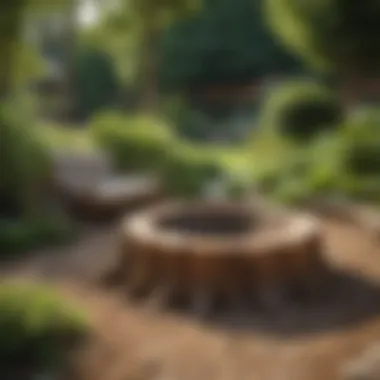

- Stump grinder rental: $50 to $100 per day.
- Professional grinding services: $200 to $600, depending on stump size and depth.
- Hand tools (saws, axes): $30 to $100.
DIY vs Professional Stump Removal
Deciding between DIY and hiring professionals involves evaluating several considerations, including skill level, equipment availability, and cost-efficiency.
DIY Stump Removal:
- Pros:
- Cons:
- Cost Savings: Homeowners can save on labor costs.
- Control: The ability to work at one's own pace.
- Experience Gained: DIY methods build skills for future projects.
- Time-Consuming: Removing a stump can take significant time.
- Physical Effort: This method requires considerable physical strength and endurance.
- Potential for Unfinished Work: Without proper equipment, stumps might remain partially buried or not fully removed.
Professional Stump Removal:
- Pros:
- Cons:
- Efficiency: Professionals have tools and experience to complete the task faster.
- Guaranteed Results: Likely to leave the property clear of remnants.
- Safety: Lower risk of injury when experts handle difficult jobs.
- Cost: Hiring professionals incurs service fees, which can be high depending on the method used.
- Scheduling Conflicts: Availability might be an issue, leading to longer waiting times.
Determining whether to attempt DIY stump removal or hire a professional will depend on your specific situation, including budget and willingness to commit the required time and labor.
Environmental Impact of Stump Removal
Removing tree stumps has not only aesthetic and practical benefits for homeowners, but it also holds significant implications for the environment. Understanding these impacts is crucial for making informed decisions regarding stump removal methods. This section delves into the effects on local ecosystems and explores sustainable practices that can make the process less harmful to the surrounding environment.
Effects on Local Ecosystems
When a tree is removed from a landscape, the stump left behind can disrupt local ecosystems. Tree stumps serve as a habitat for various insects, fungi, and small wildlife. Some species rely on decaying wood for sustenance or shelter. When these stumps are removed, those organisms may lose their habitat, causing an imbalance in the ecosystem.
Moreover, stumps play a role in the nutrient cycling of the soil. As they decompose, they return valuable nutrients to the soil. If stumps are disposed of improperly, it can lead to an excess of debris that might not decompose as beneficially as the stump itself would have. This accumulation may hinder soil remediation processes and affect the growth of surrounding plants.
Understanding these environmental consequences allows for more ecologically responsible stump removal practices that minimize negative impacts on ecosystems. Homeowners should consider these factors before proceeding with any stump removal method.
Sustainable Practices in Stump Removal
Utilizing sustainable practices in stump removal can mitigate adverse effects on the environment. Here are some approaches to consider:
- Evaluate the need for removal: Before deciding to remove a stump, it is essential to assess the reasons behind the decision. If the stump does not pose any hazard or interfere with garden design, leaving it in place may be a viable option.
- Opt for eco-friendly removal methods: Chemical treatments can have harmful effects on the soil and surrounding plant life. Instead, consider using natural alternatives, such as vinegar or boiling water, to assist in decay. These methods are less intrusive and can effectively break down the stump over time.
- Composting: If removing the stump is unavoidable, consider repurposing the materials. Shredded stump material can contribute to a compost pile, enriching the earth as it decomposes.
- Replanting native species: After stump removal, replanting can reinstate the ecological balance. Introducing native plant species not only supports local wildlife but also enhances soil health.
The End
Removing a tree stump is not just about aesthetics; it plays a crucial role in lawn health and safety. An intact stump can be a breeding ground for pests, including termites and ants, which may later invade your home or nearby trees. By addressing stumps promptly, homeowners can not only enhance the visual appeal of their yards but also improve the overall health of their landscaping.
Furthermore, the methods of removal can vary significantly in terms of effectiveness and environmental impact. It’s important to weigh the options of mechanical versus chemical methods. Each carries its own set of associated costs, labor requirements, and potential harm to surrounding flora.
This guide has provided various approaches to stump removal tailored to different homeowner needs. Adhering to the discussed safety precautions ensures that the process can be both safe and efficient. The post-removal considerations also emphasize the importance of filling the void left behind and deciding on future landscaping options. This can contribute to a well-kept yard that aligns with your gardening aspirations.
In summary, understanding these best practices is vital to achieving successful stump removal. Not only does the process enhance your outdoor space, but it also supports a healthier ecosystem in your garden. Taking the time to properly execute each step can yield substantial long-term benefits for both your property and the environment.
Best Practices for Successful Stump Removal
To ensure successful stump removal, consider the following best practices:
- Choose the Right Method:
- Plan Ahead:
- Always Follow Safety Guidelines:
- Consider the Environment:
- Care for the Surrounding Area:
- Evaluate your specific situation. If time is not an issue, chemical methods might work, but for quicker results, mechanical methods like stump grinders are best.
- Think about what you want to do with the area after stump removal. Will you replant, build a patio, or leave it open? Knowing this can guide your removal technique.
- Use personal protective equipment such as gloves, goggles, and ear protection when operating machinery. Safety should always come first.
- When using chemicals, select products that are environmentally friendly to minimize adverse effects on your garden's ecosystem.
- Ensure that nearby plants and structures are protected during the stump removal process, especially when using heavy machinery.
By adhering to these practices, homeowners can effectively remove tree stumps while optimizing their space for future use. Engaging with the process methodically will result in positive changes in your yard without compromising safety or environmental health.















